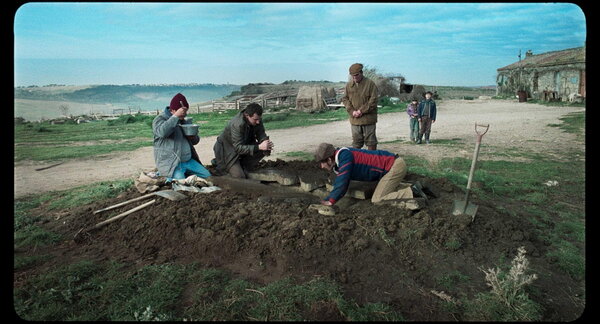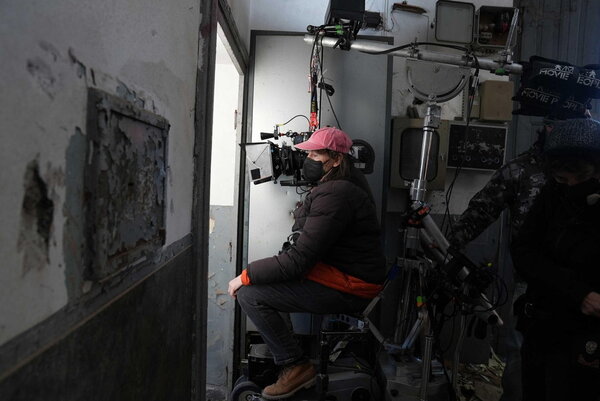DP Hélène Louvart AFC speaks to Kodak on how she mixed 35mm and 16mm formats and aspect ratios to bewitching effect for Alice Rohrwacher’s ’La Chimera’
Set in Tuscany during the 1980s, the film follows Arthur, a disheveled, chain-smoking and once-respectable English archaeologist. He is freshly released from prison and returning by train to the rural town where he and his motley band of ’tombaroli’ (tomb raiders) earn a meager living trafficking ancient Etruscan artifacts they loot from dark, subterranean catacombs.
Arthur dreams of Beniamina, the woman he loved, now presumed dead, and visits Beniamina’s ailing, elderly mother Flora who lives in a decrepit villa, where she is surrounded by predatory daughters and supported by Italia, a young housemaid who is keeping two children secretly in the house. Arthur yearns to be reunited with Beniamina in the spirit world, and legend has it that a buried door joins this world to the next. Yet despite the allure of dreams and visions of beyond, his nascent connection with Italia hints at the treasures real life can hold.

La Chimera was selected to compete for the Palme d’Or at the 2023 Cannes Film Festival. It earned critical acclaim worldwide for Rohrwacher’s portrayal of Italy as a treasure trove of past and present glories, and kudos for the exhilarating fusion of realism and magical realism in Louvart’s shape-shifting cinematographic style.
Filming took place across two separate five-week stints, during the winter and summer months of 2022, at locations around what was ancient Etruscan Etruria. These included : the hill town of Montalcino and the Asciano-Monte Antico railway in southern Tuscany ; the communes of Tarquinia, Blera, San Lorenzo Nuovo and Civitavecchia in northern Lazio ; and Castel Giorgio in Umbria. Although there is an abundance of human-made subterranean passageways, catacombs and burial chambers in these areas, access limitations meant that some of the underground sets had to be specially constructed. Filming also took place on Frasca beach and the nearby Torre Valdaliga Nord coal-fired power station.
La Chimera marks Louvart’s continuing collaboration with Rohrwacher. The pair previously worked together on the coming-of-age drama Corpo Celeste (2011), shot on 16mm, The Wonders (2014), which won the Grand Jury Prize at the 2014 Cannes Film Festival and was framed again by Louvart using 16mm, Rohrwacher’s 2015 short De Djess, which harnessed 35mm film, and the much-acclaimed Lazzaro Felice (Happy As Lazzaro) (2018), which was captured on 16mm.

"Alice’s scripts are always interesting, and this story about the real world, the under-world and the space in-between, was really intriguing to me," says Louvart about her initial discussions with Rohrwacher about La Chimera. "On each production we evolve our visual storytelling style. Corpo Celeste was completely handheld. The Wonders had a more controlled handheld style, and I framed Lazzaro Felice largely from an objective perspective, to see things through Lazzaro’s eyes.
"We wanted to try something different for this production, to mix different ways of shooting – handheld, easy-rig, tripod and dolly, using prime and zoom lenses – so as to have a more lively and fluid camera than we’d ever had before.
"We also wanted to find ways to subtly separate the depiction of Arthur’s daily life against what’s happening beneath his feet and his melancholic reveries. After some discussion we came up with the idea of mixing between camera formats to do this. We decided to shoot in Super16mm in 1.66:1 aspect ratio for daily life, on 35mm in 1.85:1 for anything Etruscan or anything linked with the Etruscan spirits or souls underground, and to harness regular 16mm film in 1.33:1 for Arthur’s daydreams, flashbacks of Beniamina, and other memories."
[...]
- Read the whole article on the Filmmaker Stories blog by Kodak.
- Read more Filmmaker Stories by Kodak.
 En
En Fr
Fr






